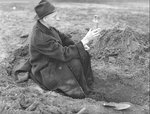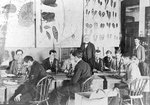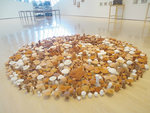


One night this spring, on an undisclosed date, in an undisclosed patch of earth near MSU’s Beal Botanical Gardens, a group of excited plant biologists will follow a map to a treasure that is unique in the world.
They’ll dig about two feet down to unearth the 16th of 20 glass bottles, each containing 1,050 seeds, buried in 1879 by visionary MSU botanist William Beal. They will bring the 141-year-old seeds to a lab, plant them and see what germinates.
The next bottle will be unearthed in 2040, and so on, every 20 years until 2100.
The Beal Seed Viability Experiment started out as a way to investigate how long 21 species of weeds can stay dormant in a farm or garden and survive to germinate. But over the last century and a half, its longevity has captured the imagination of scientists, botanists, gardeners and, now, artists.
To mark this spring’s milestone in one of the longest-running scientific experiments in history, MSU’s Broad Art Museum has launched a thought-provoking new exhibit, “Seeds of Resistance.”
The exhibit shows how Beal’s visionary experiment presaged modern seed vaults, including a “doomsday vault” in Norway where thousands seeds are preserved in case of planetary disaster. Blending science and art, the images and objects in the exhibit unlock the vast potential of humble seeds, both real and metaphorical, to feed our bodies and minds — from lush apple orchards, turgid beans and artfully preserved botanical specimens to a future vision of seeds in space.
Germ of an idea
The only person alive who has touched the bottles of seeds William Beal buried in 1879 is Frank Telewski, a plant biologist and curator of Beal Botanical Gardens.
“You’re down there on your knees, brushing the topsoil off the tops of the bottles and selecting a bottle and removing it,” Telewski said. He described the 2000 dig in an interview on view at the Broad exhibit. “You can’t help thinking that the last person to touch the bottle was Professor Beal. That’s heady stuff.”
Beal is an MSU icon, a pioneer in the development of hybrid corn, correspondent with Charles Darwin and founder of the oldest continuously operated university botanical garden in the United States. The Broad exhibit begins with rare photographs of Beal, research notes in his own hand, specimens he collected and a box of seed jars he put together.
The seed experiment a wonder all by itself, but it gave Broad Museum curator Steven Bridges the germ of a broader idea.
Beal’s bottles, drifting through the sea of time, reminded him of a series of beautiful photographs by Texas-based artist Dornith Doherty, “Archiving Eden,” begun in 2008. Eerie images of the bunker-like Svalbardd Global Seed Vault on Spitsbergen Island in Norway, reproduced in a dramatically large format at the Broad, fill the viewer with hope and dread.
This blank-walled bunker in the Arctic is called the “doomsday vault,” built to store up to 2.25 billion seeds and more than 2,500 plant species as a global backup system in case of disaster.
The artist called it a “profoundly optimistic and pessimistic project.”
“There’s something awe-inspiring, a little bit sci-fi, about this concrete vault inside of a mountain in the Arctic,” Bridges said.
The vault is not a theoretical mind game or demonstration piece. The first withdrawal from the seed bank was made in 2015, when civil war and climate change ravaged crops in Syria.
“They had to go inside and extract a specific variety,” Bridges said. “So it’s already happened. It’s real.”
Bridges deliberately positioned Doherty’s seed vault images, including a look inside the Svalbard vault, near the Beal memorabilia to link the leisurely MSU experiment to an era of more urgent concern over the fate of seeds.
He considers the seed vaults depicted in Doherty’s photographs to be an extension, or even the culmination, of the long-range thinking Beal put into practice at MSU.
The Beal project itself changed in scope over a century and a half. At first, the jars were to be opened every five years, but Beal’s successor, H.T. Darlington, extended the period to 10 years. At about the mid-20th-century, MSU’s plant science faculty decided to stretch the period to 20 years, pushing the last jar all the way to 2100.
The experiment has gone on so long by now that scheduled jar excavations have been delayed by two global pandemics — one in 1919 and another in 2020. The seeds were supposed to be opened last spring, but Telewski had to put if off until this year,
Fort Knox of dirt
People who associate contemporary art with immersive light shows, vivisected sharks or giant metal balloon animals may be surprised at the contemplative, spare tableau in the Broad Museum’s main gallery.
The sunlit room evokes a hushed botanical lab more than an eye-popping contemporary art display.
Often, the direct sunlight in the Broad’s main gallery hems in the curators’ choices, especially when it comes to fragile photographs, prints and other works on paper, but the natural light is perfect for “Seeds.”
Right under the gallery’s largest window to the southwest, a rich display of dried plants (“Herbarium,” by American artist San Van Aken) melds scientific research and exquisite graphic art. Van Aken uses grafting to create living artworks that also serve as a genetic store of rare, endangered species. He presses the plants to squeeze moisture out, just as Beal did when logging specimens. He positions the stems, seeds and flowers so every significant detail is visible to researchers while making sure the composition is aesthetically harmonious. Some of the works in the stash at the Broad are the last known specimen of a species.
Works like Van Aken’s “Herbarium” celebrate the life embodied in seeds, but the Broad exhibit isn’t shy about confronting the damage wrought upon the living world by modern civilization.
Chicago artist Claire Pentecost calls soil “the other half of seeds.” Her provocative “Soil-erg” display features stacks of bricks made of compressed topsoil, like the gold in Fort Knox. If our priorities were in harmony with life, the sculpture suggests, vaults would contain life-giving seeds and soil, not toxic gold.
Fun with fungi
To appreciate a tiny seed, the beholder must look closely, imagine what it can become and wait patiently for it to get there. For the most part, “Seeds of Resistance” is much like its subject, an exhibit that rewards slow contemplation and doesn’t try to dazzle.
A few of the works on display, however, knock at least one sock off without deviating from to the exhibit’s serious intent.
A delightful circle of about 1,000 clay mushrooms springs right out of the shiny museum floor, smack in the middle of the main gallery. Spanish artist Antonio Ballester Moreno’s “Live the Free Fields,” made in collaboration with students from schools in São Paulo, dares you to kneel on the ground, with one eye on the nearest security guard, and scrutinize every stalk, head and mycelium.
Fungi aren’t plants, and they reproduce by spores instead of seeds, but revolutionary new research is revealing the nearly invisible threads fungi weave in the soil, connecting plants up with nutrients and even helping trees communicate with each other in a “wood wide web.” The circle of mushrooms on the floor is a bare hint of the hidden tangle of interconnected life woven under our feet.
Meanwhile, directly overhead, a combination of a Sputnik, a geodesic dome and a chrome spermatozoön seems to drift toward the gallery’s main window. The striking object bears the NASA-like name “Generosity 1,” a sculpture by El Salvador-born artist Beatriz Cortez. A closer look reveals that the Sputnik is studded with glass bubbles containing seeds specific to Central and South American cultures such as sorghum, tamarind and gourd varieties.
“She pulls from ancient indigenous knowledge, but with a touch of science fiction,” Bridges said. “She takes these ancient seed varieties that are culturally rich, and specific to the place where she’s from, and throws them into space.”
Like Doherty’s photographs of the Svalbard seed vaults, Cortez’s seed-studded Sputnik provokes conflicted feelings.
After the initial “ooh” at the shiny thing comes another reality check: Why would we send seeds into space anyway? Most likely, because we have screwed things up on Earth and are rolling the dice of survival into an uncaring cosmos.
“It sounds like science fiction, but oftentimes science fiction becomes reality,” Bridges said. “We may not be that far off from putting seed banks into our atmosphere.”
Diminishing returns
When Frank Telewski sets out this spring, shovel in hand, to dig for the 16th jar, MSU plant science Professor Marjorie Weber will be by his side. Weber is among a handful of younger colleagues Telewski has picked to go with him this time around, in the hope that one or more of them will take over the experiment in 2040.
“Ill be 85 years old in 2040 — I hope,” Telewski said.
“And they’ll pass it along to the next generation, until the experiment is done in 2100.”
Weber said the meaning of the experiment has shifted drastically from Beal’s goal of understanding weeds in order to control them.
“Now we’re more into the realm of wanting to understand how we can store seeds for conservation, how long they might last if there are major disruptions to the ecosystem,” Weber said in an interview on view at the Broad.
If people read the book of seeds closely and lovingly, it will yield lasting and profound profit, and not just for farmers and gardeners.
“They hit the ground and hang out until conditions are right until they can germinate and grow,” Weber said. “That long-term perspective is built into a plant’s life cycle, and it’s different from the way humans operate. We can learn a lot about how to be on this planet, long term, from plants.”
There is one final lesson to be learned from seeds. No matter how miraculous and resilient they seem, they don’t last forever.
As the decades roll by, the Beal Seed Viability Experiment is confirming what every gardener with a drawer full of unused seeds already knows — seeds have limits.
Enshrined in the glass case at the Broad exhibit is a dried specimen of a small wildflower called verbascum blattaria, or moth mullein. The lovely pink blossom, with a stamen that resembles a moth antenna, has been labeled a “noxious weed” in the state of Colorado, but it’s the undisputed champion of the Beal experiment.
When the 15th bottle buried by Beal was unearthed in 2000, half the verbascum seeds, 120 years old at the time, germinated — about 23 plants, plus two more related plants that were hard to identify. Only one other plant — a little purple flower called malva, or mallow — sent up a seedling.
It’s worth taking a few seconds to salute a tiny package of genes and nutrients that began life in a horse-and-buggy era, when a bearded scholar named Theophilus C. Abbot was president of Michigan Agricultural College, and made it through two world wars, two pandemics and 27 U.S. presidents to put out a little flower in the Internet age.
However, the rest of the seeds in the Beal experiment brought up a big fat row of zeroes in 2000, as they have since about 1930. Every now and then, a seed variety that showed no life in one excavation pops back up in the next, but the overwhelming trend is one of decay. It’s possible that future jars will yield up nothing but verbascum and maybe not even that.
The conclusion isn’t hard to draw. It’s not enough to put seeds in a vault or glue specimens on paper for the benefit of future humans who may or may not have their act together. Even seeds won’t wait forever.
Support City Pulse - Donate Today!
Comments
No comments on this item Please log in to comment by clicking here